In conjunction with the recent solo exhibition of Colin Sherrell’s That’s Right, It’s All About Me, at the University of St. Francis Art Gallery, Jennifer Moore, Gallery Director, had the opportunity to sit down with the artist and discuss his diverse body of work produced over a sustained period of time. This week the COMP Magazine offers insight into a life immersed in art, Sherrell’s family of artists, the intersection of craft and conceptual ideas, and why the artist’s ego sometimes surfaces in his aesthetic practice.
JM: Jennifer Moore, Gallery Director
CS: Colin Sherrell, Artist
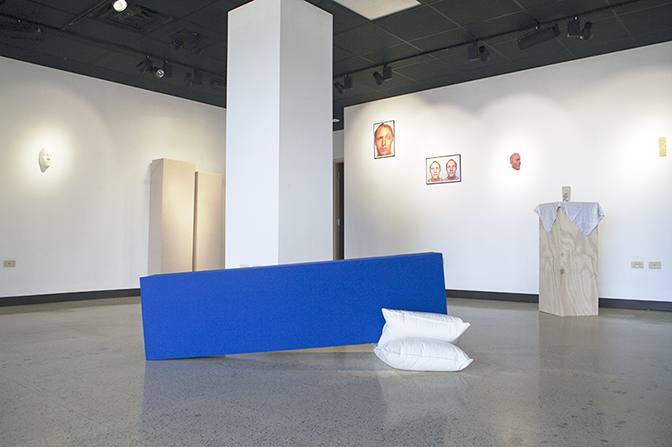
Colin Sherrell, At Rest, indigo linen on pine with king pillows, installation view,
University of St. Francis Art Gallery, Joliet, Illinois, 2018
JM: Tell us about your background: education and growing up in the Midwest and how it influenced your work. How did your education prepare you as an artist? What, if anything, weren’t you prepared for?
CS: I started my art career early in life but didn’t fully realize it until my early twenties. I spent most of my youth playing around with friends, having fun, and even getting in a little trouble here and there… I partied hard from 18 to 21 and consider myself rather lucky to make it past those years. When I was here I was a rather rambunctious kid and considered a weirdo in high school. I was one of the few art kids back then and it lead to some strange situations. When I turned twenty one I moved to Miami FL to start pursuing the “beginnings” of my art career. As I said before I started my art career early, making work from the early age of 3 and continued to make things all throughout my youth, but I never really knew what I was doing or why I was doing it. A year after moving to Miami I applied to New World School of the Arts. I quickly realized how naïve I was and reminded that I really never knew what I was doing. I mean in so many ways I knew what I was doing, but I didn’t have the direction or focus I have today.
I was very experimental back then, making whatever came to mind or just came out of me. I started out making abstract paintings, but always found myself more interested in process of working the paint or choosing the style to paint in rather than the final piece. I also preferred the hands on approach to art making and found that sculpture provided that extra little something. My first sculptures were mainly assemblages, ceramic architectural forms, and stone carvings. With the drop of a hat, during my first semester at NWSA, I went from formal or traditional sculpture to referencing traditional sculpture through conceptual craft based sculpture. The combination of growing up in a house full of art, the influence of the city of Miami itself, and the education I received, opened my eyes to how big the art world was and all that I didn’t know. My education taught me to always be researching and pushing the boundaries of what I am making. My professors, too many to list, were top notch artists at various levels in their own careers; they provided real world experiences, a wide variety of topics, conversations, theories, and lessons. They taught me to not make what looks like art and how to start making real art. They drove out all the doubt in my mind that there was any other path that I should be on.
At first it, in art school, I found that it was difficult to open up to all the new concepts I was learning, but with guidance of my father, I was encouraged to listen, open up, be accepting, and take all that I could from the experience at NWSA. I’m thankful I listened because I didn’t truly realize till college what I was getting into being an artist. Even with having my father Steve Sherrell, who is a talented and recognized artist, I didn’t know how hard it was to be an artist.
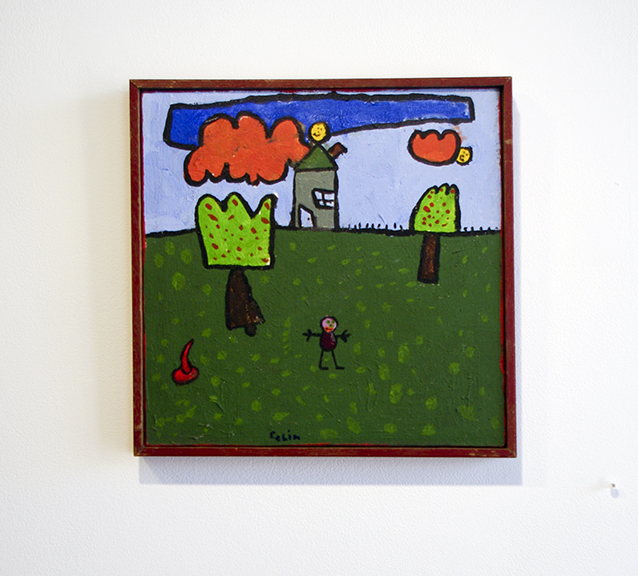
Colin Sherrell, Still Sunny, acrylic on canvas, installation view, University of St. Francis Art Gallery, Joliet, Illinois, 2018
JM: You grew up in a family of artists. You address that point in this series. Can you tell us how that has affected you as an artist and what influence this had on this series, in particular?
CS: As I mentioned before my father is an artist too, but so was my grandfather, Charles Sherrell, my dad’s dad. My mom also has tendencies towards the arts as she quilts and used to sculpt. My sister and cousin work in interior design and both of my father’s brothers Doug and David Sherrell make art. Growing up in a house/family full of art and artists filled and surrounded my life with creativity. Seems like when growing up most of the things in my life, most of the places we went, and most of my experiences revolved around the arts. Growing up, my dad would bring me to galleries and museums locally and nationally. Then additionally, throughout my teens we started to travel internationally. These opportunities to travel, at a young age, gave me a high level of exposure to the international art scene.
This saturation of arts in my life has influenced my own art in so many different ways. For instance, I tend to reference traditional sculpture in my work. I find that I am particularly vulnerable to drawing influence or directly appropriating styles, ideas, processes, tendencies, and theories of many facets of the art world. The school of art I was taught continuously drove the idea to observe the art world while being highly aware of the work from the past. History teaches us where to go and where to steal work from. I find that work from the past/history has many avenues that are still unexplored and open for investigation. As far as this show is concerned, not only does it pull from the past, making direct references to artists like Robert Morris or Bruce Nauman, but it also references styles, ideas, and approaches seen throughout the history of art. Ideas seen in the days of ruling monarchs are portrayed all the way through to ideas of today’s self-identity and personal existence in this self-driven narcissistic world.
This show includes works from my own personal past, made when I was a young boy, up to hours before the opening of this show. In this show in particular, I have taken many approaches to the work including painting, photography, sculpture, and drawing. As I mentioned before my father is a painter and computer artist, my grandfather painted and did department store window displays/installations, and my mother quilts; all of these aspects have been addressed in this show. The painting/sculpture Pierced and Tattooed consists of a stretcher made to the exact scale of my body’s height and width. The canvas was provided from my father and left raw for conceptual reasons relating to the theories behind the Tabula Rasa and the blank slate. Tabula rasa refers to the epistemological idea that individuals are born without built-in mental content and therefore all knowledge comes from experience or perception. After stretching the canvas, I painted my only tattoo and pierced the canvas in the location of my piercings. The idea of using my dimensions for a painting size relates directly to me being the son of a painter. It also references the concepts Robert Morris explored in the 70s. I am the product of Steve and Sally Sherrell and consider myself one of their ultimate creations.
In All About Colin I displayed the baby blanket my mom made for me on a pedestal. On the blanket is a pamphlet story I made when I was a kid. When my mom found out the theme of this show she gave me the blanket and story bundled together. Immediately upon receiving them I knew they had to be shown. The story in short says “Most of the time I’m alright. Sometimes I’m mad.” which is still the case some 25-30 years later. The blanket when it was placed in my hands brought immediate comfort, and I was so happy to have it back. The story gave me so many answers to who I am and who I was. Other works in the show include a painting my grandfather made of me when I was 9 years old titled A Nice Day, a drawing my father made of me and my sister when I was 4 and she was 16 titled Merry Christmas, and a 4 piece photo montage called Faces of Family which depicts my face split in half with my mom, dad and sister’s faces.
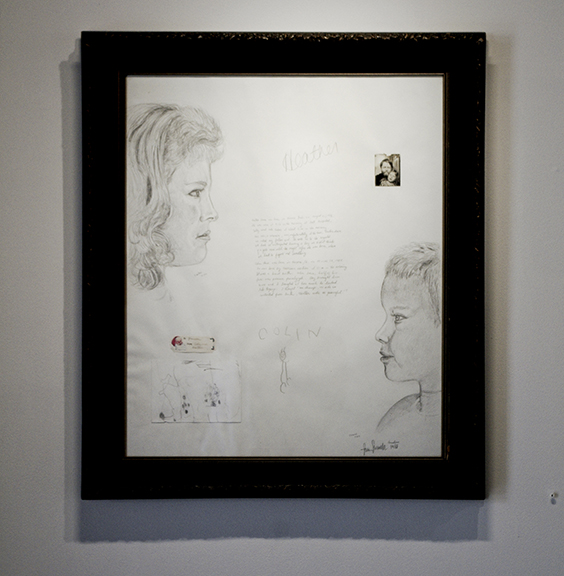
Colin Sherrell, Steve Sherrell’s Merry Christmas, mixed media, installation view,
University of St. Francis Art Gallery, Joliet, Illinois, 2018
JM: I first encountered your work in the series, Coming Home at the Laura A Sprague Gallery. The work, I believe, addressed your move and experiences as a Midwesterner living in Miami and is noticeably more colorful than the work included in That’s Right, It’s All About Me. Can you talk about the application of color (or lack of), and specifically how it relates to the series, That’s Right, It’s All About Me?
CS: Color in my work has always been rather void. I prefer to use it when I need it. For me color is a variable or a tool or a skin to be used as an influencer in feeling, thought, psyche, etc. and is only necessary when it needs to be. With that said I do break my own rules, but I rarely use color just to use it.
In this show all the color present has conceptual reasons for use. In the piece It’s Me Baby I showcase a crate built to the scale of me as a baby upon a baby blue pedestal. The crate for some has be seen as morbid; the addition of the baby blue color on the pedestal helps soften the emotion found in the form of the crate. In the piece At Rest, I have an indigo blue linen tabula rasa (blank form at the scale of my body’s height, width, and depth) resting and lying on its side on the ground upon two natural cotton king pillows. The blue linen was chosen to represent my emotions after, recently, having a piece of art work destroyed. I choose to use blue in another piece called Blue Belly, but in this case the blue represents the pains I feel in my stomach. The choice of applying color, in all the work, calls to the idea of the piece at hand. The work Green Thumb is a life cast of my hitchhiker thumb in green clear glass. The title literally references my interests in horticulture and the term given to those with the natural ability to garden.
A few other works have color in them, but the majority are either raw or true to the color of the material used. I see the original materials used as having their own skin the same as I see color a skin. Most of the time the objects I make don’t need a second skin. The color of the material can be true to its self.
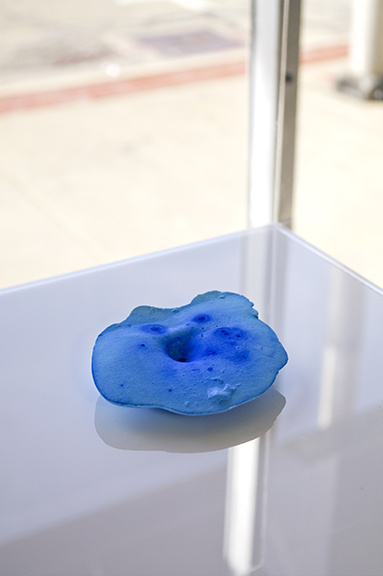
Colin Sherrell, Blue Belly, acrylic on plaster, installation view,
University of St. Francis Art Gallery, Joliet, Illinois, 2018
JM: You describe your work as “simple, clean, cool, and minimal.” The work (That’s Right, It’s All About Me) as a series is very conceptual in nature and slightly whimsical in feel, yet seems to be dealing seriously with family ties, family history and finding your place. Tell me how you and why you approached this from a conceptual standpoint. What were some of the difficulties you encountered approaching this topic conceptually?
CS: I like that you ask what some of the difficulties I encountered were. Focus was one. I had a rather broad topic that I was working with. This broad topic lead me to a wide variety of new ideas and a list of older work to choose from. I have been working with this idea for a long time, my whole life it seems, but I didn’t realize it until I started putting all the pieces together. I have work that ranges from 1984 to 2018. I was born in 1984 so for me this is truly a lifetime’s worth of work.
Sourcing some of that old work proved the next challenge. I had to look through all my archives of completed and uncompleted work. I had to find and ask my parents to source things I made during my childhood. I had to go through multiple storage locations and go through work that has been damaged do to floods or improper storage. At first, when I started to figure out my approach with this show, I had so many pieces that all went in different directions. After looking through over 50 or so works I narrowed the show down to pieces that solely revolved around my physical presence. Every piece in this show is considered a self-portrait, but some if not most blur the lines of traditional self-portrait.
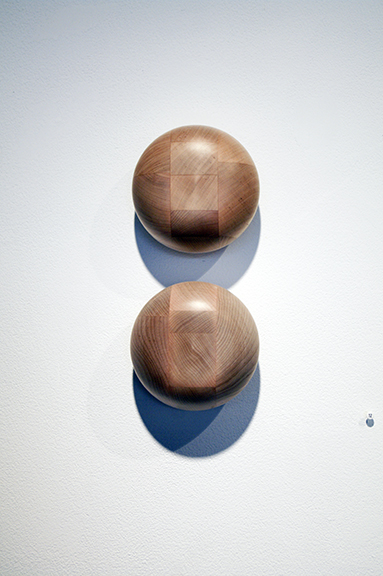
Colin Sherrell, Colon, maple, installation view,
University of St. Francis Art Gallery, Joliet, Illinois, 2018
JM: What role do the materials you use in your work play? How important is the medium?
CS: Absolutely 100% important and one of the driving forces behind my work! Usually for me the material, idea, process, scale, the color/finish (if any), and method for display are all equally important and are carefully considered with each and every piece I make. Material like color is chosen for conceptual reasons and when I choose any said material I tend to want to showcase it for what it is. If not, it gets a skin of another choice material. I prefer tactile materials over painting materials but both have their role.
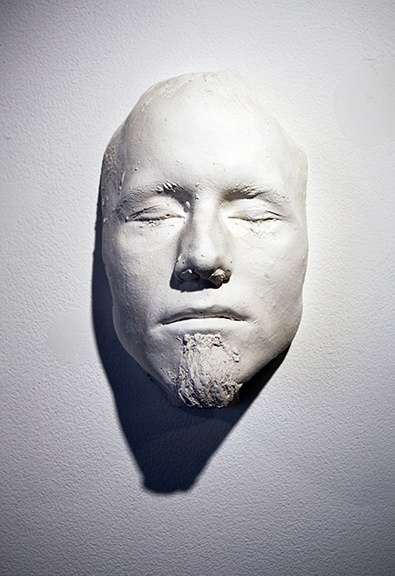
Colin Sherrell, Death Mask, plaster, installation view,
University of St. Francis Art Gallery, Joliet, Illinois, 2018
JM: This show is very conceptual in nature and exhibits impeccable craftsmanship – something that we don’t always see paired so seamlessly. So, let’s talk about that dirty little word: craftsmanship. Tell me how and why it plays a role in your work and what sort of struggle you encountered using it in a conceptual series or as a conceptual artist.
CS: Dirty little word is right! Craftsmanship (or craft) is a very confusing concept in the art world. It is both praised and shunned upon and considered both evil and enlightening at the same time. Artists tend to avoid the word altogether in fear of the connotations behind it. It seems like no one really knows what craftsmanship is or how to use it and has been on the forefront of debate since the beginning of art. I think in the real world with functional goods, craftsmanship can hold a true definition of what is high or low levels of craftsmanship, but definitions get blurry in the art world.
Artists all define their own craftsmanship and have a level of what is acceptable in their own world. For me a high level of well executed artisan craftsmanship is important for visual weight, sustainability and to fulfill a sense that I have to make something the best I can. I know that I want my works to test time and craftsmanship helps. I have made works that have been damaged and destroyed by me and by others, but with good craftsmanship, I’ve found that, at least in the case of my work, getting damaged or destroyed is narrowed.
Other than that, craftsmanship to me is important in my own work because I have personal standards to uphold. I grew up looking at the best of the best works going from museum to museum. Then in my teens when we started traveling to Europe, I saw that the level of craftsmanship that old Europe had differs greatly from the craftsmanship we see today. While in Miami I also worked as an art handler/preparator/fabricator for the Perez Art Museum Miami. There I handled thousands of works from blue chip artists with the highest the levels of craftsmanship.
Craftsmanship is something that can be seen as coming and going and a concept that gets confusing throughout time. When I went to school, the education I received, taught me that I should apply high levels of craftsmanship while at the same time deskilling myself and making art without the traditional sense of craft or craftsmanship. The dichotomy I found in craftsmanship has been an ongoing learning experience and when I approached this show I faced new challenges never seen in my own work. Some of the works in this show don’t necessarily exhibit that level of craftsmanship I hold today, but they did when they were originally conceived. On the other side even if some pieces were not made to that physical level of craftsmanship I seek, the conceptual level of the of idea crafting and reasoning is and was present. It’s difficult sometimes balancing conceptual and craft orientated work, but if one falls flat the other is there to level the field.
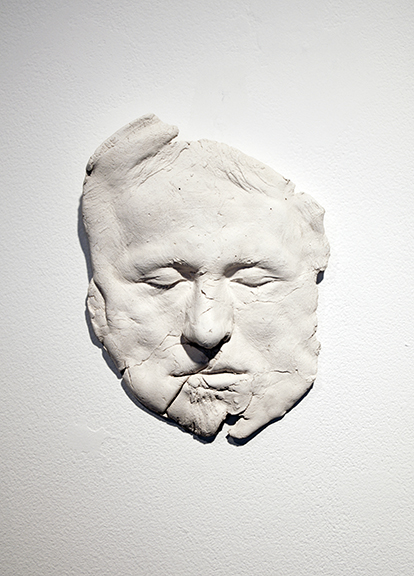
Colin Sherrell, Flat Face, ceramic, installation view,
University of St. Francis Art Gallery, Joliet, Illinois, 2018
JM: Your work exhibits a strong dichotomy – theoretically, conceptually and/or materially. Can you touch on how your personal view affects the idea of dichotomy in your work, in whatever manifestation it takes?
CS: I’m glad you see these! Dichotomies are another facet of my work that plays heavily into the idea process. Like the balance of conceptual and craft, which I try to incorporate into most of my work, dichotomies are found in most if not all my pieces. Pulled from my artist statement, “I recognize dichotomies in my work; on one level my work is speaking to theory, on another level it communicates concepts, and then deals heavily with materials, craft, and processes. I incorporate metaphors reflecting aspects of interrelations between various subjects and ideas. Everything from useless/utilitarian, strength/fragility, balance/instability, domination/submission, tension/slack, new/old, and so forth are applied to some aspect of my work. Life revolves around these relationships in that there is a pair or union in all phases of our existence; yin/yang, love/hate, man/woman, life/death etc. One needs its opposite in order to exist. In my work, there is a give and take relationship that is bound together by my life and my need to make. Each piece stems from some aspect of my experience in this world and the world of art and industry. I try to take my experiences, and without overt narration, apply just enough to communicate my ideas.” Everything we do in life revolves around dichotomies; it’s our choices that speak and make us who we are. This helps me see both sides of any situation. Based off my choices and experiences I have provided myself with a life and idea bank full of possibilities.
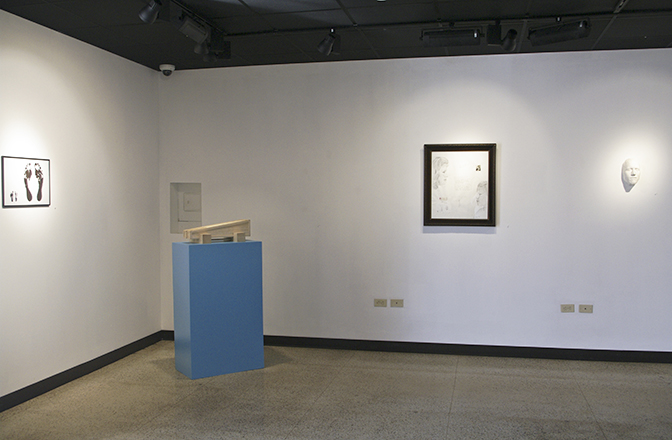
Colin Sherrell, That’s Right, It’s All About Me, installation view, University of St. Francis Art Gallery, Joliet, Illinois, 2018
JM: Do you classify yourself as a conceptual artist? If not, how to you label yourself? Are labels important?
CS: I have many labels. I’m an artist mainly, but I do also classify myself as a conceptual artist, a minimal artist, a sculptor, a painter, and so much more. I’ve been labeled a ceramic artist and a wood artist. I am all of these things. I am also a husband, the owner of a small business, a dog groomer, teacher, and preparator. I think labels are important. We need to be able to define things/people in some way or the other. They may not always be completely accurate or PC, but they help communicate who we are. When looking at artists and people in general, people tend to quickly classify others as one or two things. We all know this isn’t true as everyone has more than one or two labels.
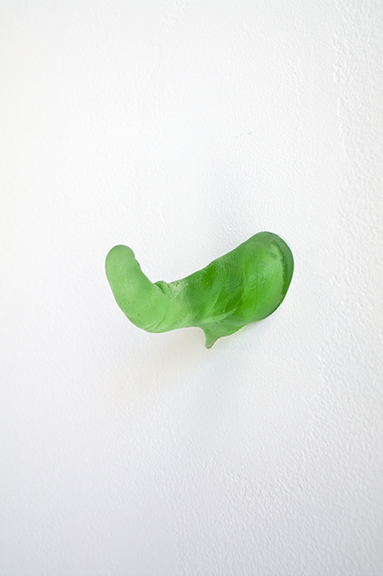
Colin Sherrell, Green Thumb, glass, installation view,
University of St. Francis Art Gallery, Joliet, Illinois, 2018
JM: Self as subject is traditionally something that artists from da Vinci, Rembrandt, Munch, and Kahlo (among many others!) have done. Each artist has approached the subject of self from a variety of viewpoints, and for a variety of reasons. Can you tell us how your exploration differs from the traditional self-portrait and why you chose to approach self as subject? Tell me why you wanted to approach self as subject and what significance it might have to those that view it.
CS: The self-portrait is definitely no new subject and one that has been seen since the ancient Egyptians and the earliest forms of Asian art. Since then it has been carried on through to today. As you mentioned many other artists throughout time have approached the self-portrait in a variety of different ways. From the earliest forms of European art with artists like Albrecht Dürer through to Di Vinci and Rembrandt to Van Gogh, Kahlo or Munch. Then from there, modern and postmodern artists alike took on new notions of how the self-portrait could be represented. The modernists reacted to all that came before them as the postmodern artist’s reacted to modernism. It wasn’t until the early postmodern artist’s, during the late 1960s and 1970s, that we started to see the use of the artists own bodies as both subject and material. I would say that in some ways my work differs from the individual approaches that many of these mentioned artist took, but in other many ways, continues some trends already seen.
In a space between resemblance and characterization, abstraction and representation, using painting, sculpture, drawing, and photography, I investigated my own place, image, and existence in this world. In the piece Mugs I pulled inspiration from the work The Duke and Duchess of Urbino a diptych by Piero Della Francesca. My piece depicts my wife and me face to face in the form of police mug shots. The commentary/theme is the same as Francesca’s, but with a postmodern contemporary twist. Other works in the show call upon the work of artists like Bruce Nauman, Robert Morris, and Chuck Close. Blue belly and Green Thumb reference Nauman whereas the Tabula’s reference Morris’ work.
The 70’s were a dubbed the “Me Generation” decade and as max Beckman states “It is the quest of our ego that drives us along the eternal and never-ending journey we must all explore. What am I? This is the question that constantly persecutes and torments me.” I also ask “What am I?”, by referencing my own image, scale, time, and relationships; I question how we as people fit together through our interconnectedness to each other, and how we physically occupy this world together. I represent myself/portrait in a variety of images and objects such as crates, canvases, carvings, death masks, body casts, and minimal form. The images range from photography, childhood paintings, and drawings, digitally manipulated photos, and works from both my artist grandfather Charles and father and Steve Sherrell. The diversity in approaches differs from most of the mentioned artists in that those artists typically worked in one territory or style with their self-portraits. Like I said before, we all have many labels, but we also have many ways to portray ourselves. I wanted to have diversity in this show because I think it’s relatable to the general audience. The works may draw other people to explore their own existence in time and space through self-analyses.
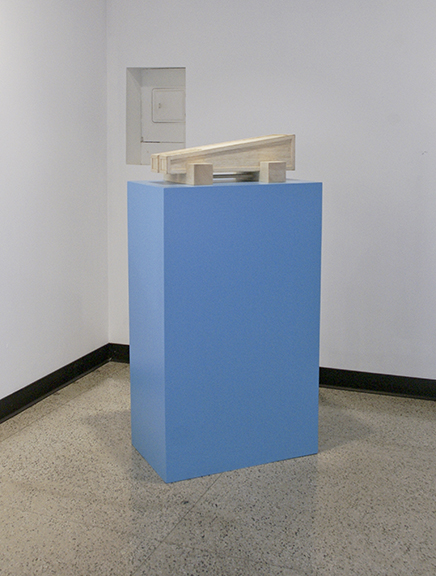
Colin Sherrell, It’s Me Baby, balsa and pedestal, installation view,
University of St. Francis Art Gallery, Joliet, Illinois, 2018
JM: Lately, it seems, there is a spotlight almost exclusively on feminism and female identity in art. I find it particularly refreshing that your work reminds us that men, too, face challenges (Works: Colon and Period). Did you set out to address challenges specific to the male experience in this series?
CS: Yes and no. Dichotomies at play here. The first work Colon was made in undergraduate school in a class where we were to present self-portraits. My name is Colin which throughout my life has been mistaken with the pronunciation of the word colon or how you pronounce Colin Powell’s name. Making satire of the situation I made this piece. Fast forward three years and a week after completing my graduate studies, I was diagnosed with having a growing tumor in my right testicle. It was benign, thank the gods that be, but they still had to take one of my testicles. After this happened and I recovered I made the Period piece, or what I call semicolon. It was originally shown in a series of works titled Minimal Art: Not Safe For Work that focused on sexuality. It does and I did want to address challenges that men too face but not specifically for this show or series. I wanted the show to be more universal than just dealing with male/female challenges. I like telling people about this piece though because it does open people’s eyes to men’s issues. We grow and learn from our experiences. Losing the testicle do to a tumor helped me to see that I needed to take better care of myself when working. I was told that what happened with my testicle is statistically seen in men, my age, 25-35 years old and who work in construction, factories, and/or the arts. Inhaled chemicals can be absorbed into the testicles like a sponge and cause growths. While at the opening reception a patron was rubbing the pieces unknowingly. I explained to her what they represented and she continued to rub them, but a bit gentler. Since the surgery I have informed many young men to be more cautious, work smart, and stay protected when working with chemicals or airborne materials. I also tell men to check themselves regularly. If anything seems suspicious don’t hesitate like I did.
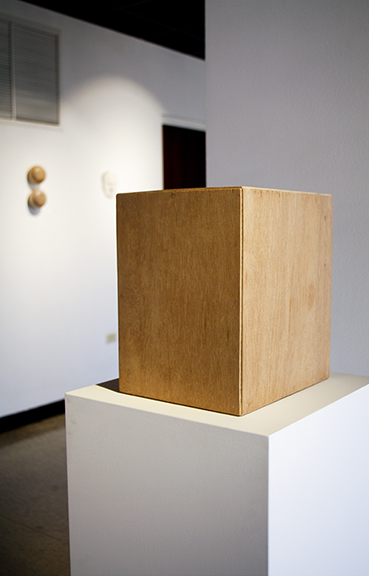
Colin Sherrell, Block Head, virola, installation view,
University of St. Francis Art Gallery, Joliet, Illinois, 2018
JM: So, what’s next? Are you working on a new series? Any upcoming shows? Where do you want to go from here?
CS: Well I have a couple more pieces to finish for this series that I ran out of time on, so those are next. Then I have been talking with my father about having a two man show with him where we take a central theme and make our own pieces as well as some collaborative works. We have never really worked together on anything specifically art wise so we thought it would be interesting to go in this direction. A compare and contrast of sorts. Although this apple didn’t fall far from his tree, this apples work did. Then I am trying to find the time to start working on some grants and/or proposals. I have a few series that I would love to make, but beyond my budget.
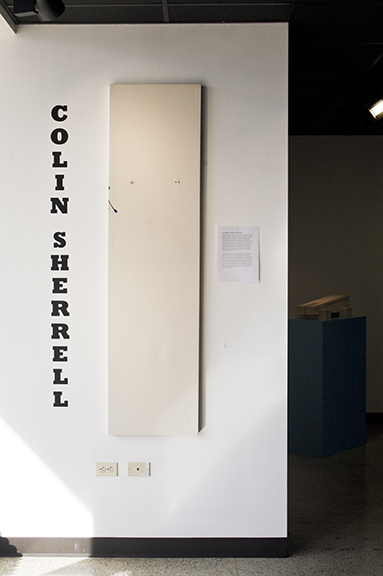
Colin Sherrell, Tattooed and Pierced, acrylic on canvas and piercings,
installation view, University of St. Francis Art Gallery, Joliet, Illinois, 2018
For additional information on the practice of Colin Sherrell, please visit:
Colin Sherrell – http://www.colinsherrell.com/
Visit Naperville – https://www.visitnaperville.com/naperville-art-and-history-exhibits/JoeMilosevichandColinSherrell
North Central College – https://www.northcentralcollege.edu/events/2018/01/31/joe-milosevich-and-colin-sherrell
Water Street Studios – https://www.waterstreetstudios.org/artists/


